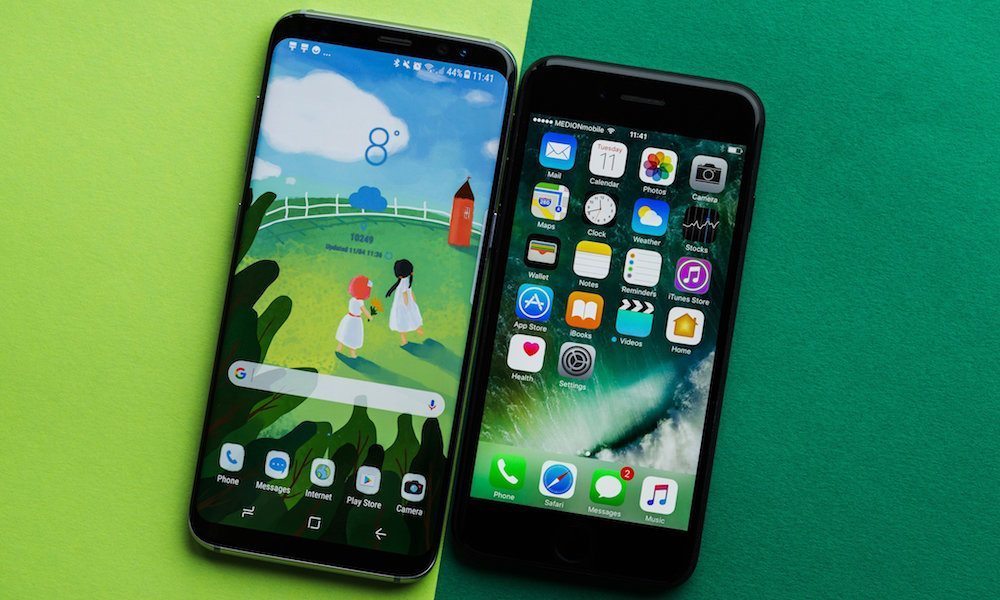iPhone 7 Remains Top-Seller as Galaxy S8 Struggles
 Credit: Android Pit
Credit: Android Pit
Toggle Dark Mode
During the three-month period ending in May, 2017, Apple’s iPhone 7 and iPhone 7 Plus flagships held onto their position as the top-selling smartphones in the U.S. market, according to the latest data provided by Kantar Worldpanel, which also revealed that Samsung’s beastly Galaxy S8 and S8+ didn’t fare quite as well as the South Korean company might’ve hoped.
With a combined market share of 20.1%, Apple’s iPhone 7 duo easily notched the top-seller slot, according to Kantar’s data, which brought Apple’s overall market share in the U.S. up 5.8%, year-over-year, to a combined 36.5%. Meanwhile, Kantar suggested “based on early indications” that Samsung’s Galaxy S8 duo captured a combined market share of just 8.1% during the same three-month period, which is surprisingly a bit lower than the 8.8% captured by Sammy’s Galaxy S7 and S7 Edge last year.
Not all is rainbows and unicorns for Cupertino on the international stage, however — particularly in up-and-coming markets like urban-China. While iPhone sales were up year-over-year in urban-China, they were actually down 3.8% during the three-month period ending in May, 2017 — as Android handsets from native Chinese manufacturers like Oppo, Xiaomi, Huawei and others captured a whopping 83.4% of smartphone sales in the country, which is up 4.3% from the 79.1% captured by Android a year ago.
“Importantly, Apple posted a strong period-on-period gain in urban China, rising to a 16.2% share from 12.4% in the first quarter of 2017, which was their lowest since early 2016,” said Tamsin Timpson, Kantar Worldpanel’s Director of Strategic Insight for ComTech Asia. “iPhone 7 and 7 Plus sales recovered slightly, now representing 8.5% of smartphones sold in the region, outpacing both Huawei and Oppo models.”
Meanwhile, in the five largest European markets of Great Britain, Germany, France, Italy, and Spain, Apple saw a sales growth of just 1.1%, year-over-year, which brought the iPhone-maker’s overall market share in those countries to 19.3%. On the other hand, during the same three-month period ending May, 2017, Android saw a growth of 2.2% in the same European markets, bringing the iOS-wannabe’s market share up to 78.3%.
Interestingly, Kantar’s predictions of a less-than-stellar sales performance for Samsung’s Galaxy S8 duo comes off the heels of a fresh report by Consumer Reports, who just yesterday crowned Sammy’s Galaxy S8 flagship as “The Best Smartphone Available.” Of course, worth noting is that there are various factors that could have contributed to Samsung’s relative stagnation in the U.S. market, including the Galaxy S8’s high price-point, for example, and U.S. customers’ overall favorability of Apple’s iPhone devices.
Worth noting is that Apple’s upcoming iPhone 8 flagship, which could also be called the iPhone Edition, will boast a premium feature set similar to Samsung’s Galaxy S8 offerings. These include a full, edge-to-edge, 5.8-inch OLED display (the same size as Samsung’s entry-level Galaxy S8), a glass-sandwich construction, wireless charging, enhanced IP68 water- and dust-proofing, and much more. The uber-premium, 10th anniversary iPhone will also demand an equally premium price, with some analysts suggesting a model with the max amount of SSD storage could run well over $1,000.
Could ‘early indications’ of Galaxy S8 sales performance be a foreshadowing of things to come for Apple’s iPhone 8? Let us know in the comments below.






